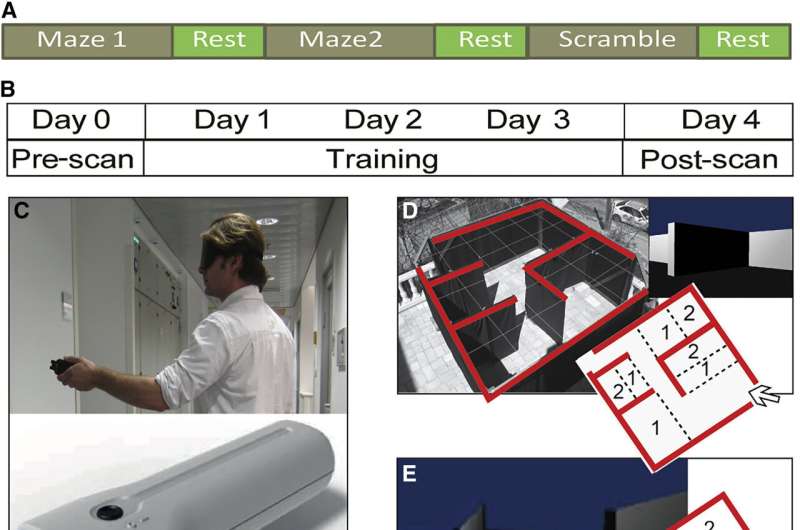
A new study by researchers at Reichman University's Brain Cognition and Technology Institute directed by Prof. Amir Amedi has shown that visual navigation areas in the brain can be activated using sound. By traversing mazes using sound information instead of visual information after training, visual navigation areas were activated.
This finding has numerous exciting implications, among them the findings chip away at the Nobel Prize winning theory of critical periods and provide new avenues for cognitive training to potentially detect and prevent Alzheimer's disease.
The team conducted a series of studies over the past years that challenge conventional beliefs about the human brain's functioning; claiming that the brain is divided by tasks, rather than the commonly accepted division by senses (seeing area, hearing area, etc...). These studies utilized Sensory Substitution Devices (SSDs), which are remarkable tools that transfer sensory information from one sense through another sense.
For example, SSDs can help visually impaired individuals "see" by converting visual information into sounds. Following training, individuals can identify shapes, object locations, words, letters, and even faces when represented through sound. Training on SSDs has been shown to be effective on people even in their 40's—60's+, calling to question the idea that there are critical periods for development of senses.
The classic theory of critical periods suggests that the senses can only be developed early in life, during childhood, through exposure to sights, sounds, and so on. And if they do not develop during this period, they cannot be used later in life. The fact that SSDs can be used for effective training well into adulthood, suggests that the theory of critical periods needs to be revised.
Taking this to the extreme, this body of research has shown that the brain can be reprogrammed through this training so that visual areas in the brain can be activated even in people with zero visual experience.
These non-invasive devices, SSDs, offer researchers unique opportunities to observe how different brain regions respond when relevant information comes from another sense. Using functional magnetic resonance imaging (fmri), the researchers in this new study examined the impact of using SSDs on visual retinotopically organized areas of the brain, in this case specifically Area V6, which is responsible for visual navigation and motion perception.
The results of this study indicate that through short training with the EyeCane, an SSD that conveys spatial information about the visual surroundings through sounds, even those who are congenitally blind can develop selective activation in Area V6.
The study further supports the idea that, despite years or a lifetime of blindness, the brain has the potential to process visual tasks and properties if the right technologies and training are employed. Additionally, the study found that the area contains motor neurons responsible for egocentric navigation.
Importantly, the findings from this study may have implications for improving detection and prevention of Alzheimer's disease. Spatial deficits are a common early symptom of Alzheimer's disease and navigation and spatial cognition rely on V6 among other brain regions. The fact that V6 can develop its selectivity for navigation in the absence of visual experience, as seen in the congenitally blind participants using the EyeCane SSD, suggests that there may be ways to train and enhance navigation abilities in individuals at risk for Alzheimer's disease, such as older adults or those with mild cognitive impairment.
Furthermore, by better understanding the neural mechanisms underlying development and functioning of spatial navigation, we may be able to identify early biomarkers and targets for interventions aimed at preventing or slowing the progression of Alzheimer's disease.
The work is published in the journal Current Biology.
More information: Elena Aggius-Vella et al, Activation of human visual area V6 during egocentric navigation with and without visual experience, Current Biology (2023). DOI: 10.1016/j.cub.2023.02.025
Provided by Reichman University
Citation: New sound navigation technology enables the blind to navigate (2023, March 3) retrieved 5 March 2023 from https://ift.tt/XHiVEFD
This document is subject to copyright. Apart from any fair dealing for the purpose of private study or research, no part may be reproduced without the written permission. The content is provided for information purposes only.
"sound" - Google News
March 03, 2023 at 09:56PM
https://ift.tt/K2EsZgc
New sound navigation technology enables the blind to navigate - Medical Xpress
"sound" - Google News
https://ift.tt/qZwhM2U
Shoes Man Tutorial
Pos News Update
Meme Update
Korean Entertainment News
Japan News Update

No comments:
Post a Comment